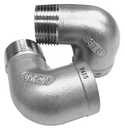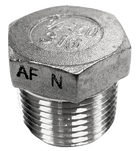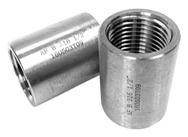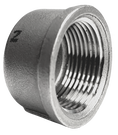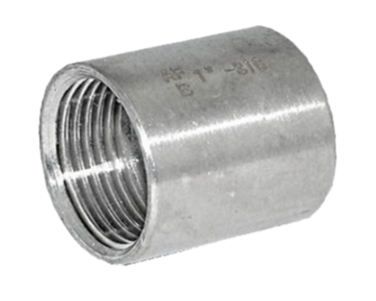|
|
|
Material Specification |
|
Connection Type |
|
Size |
|
Working Pressure |
|
Threaded fittings are low pressure fittings designed to change the flow direction in systems or as connection tools for system parts. They are also known as 150# fittings or 150 LB threaded fittings. They are made from stainless steel and brass materials.
The threaded fittings have a maximum working pressure of 150 PSI. The sizes of the class 150 fittings range from 1/8” to 4” (DN6 to DN100). They are made to control the low pressure gas or fluid. For class 150 fittings, two connection types are available. The National Pipe Thread (NPT) and British Standard Pipe Tapered (BSPT). Class 150 Fittings are suitable for low cost and non-critical applications.
The threaded fittings have a maximum working pressure of 150 PSI. The sizes of the class 150 fittings range from 1/8” to 4” (DN6 to DN100). They are made to control the low pressure gas or fluid. For class 150 fittings, two connection types are available. The National Pipe Thread (NPT) and British Standard Pipe Tapered (BSPT). Class 150 Fittings are suitable for low cost and non-critical applications.
1. What does ASME stand for?
|
Threaded fittings are tools designed to create connections between pipes and tubes of different sizes and shapes. They are used to create fluid flow in plumbing devices and hydraulic systems. These fittings are also called 150 LB fittings or class 150# and are produced with the adherence to ASTM A351 CF8M/316 stainless steel matter. These fittings are produced using various standards such as the American Society of Mechanical Engineers (ASME), American Society for Testing and Materials (ASTM), and so on. For hydraulic fittings, they are designed with the working pressure which defines the type of tubes and systems to be attached to them. Threaded fittings are produced in different variations.
|
Class 150 fittings are a type of threaded fittings used in hydraulic systems for connections with components or to pave way for fluid flow. The fittings can serve as a regulator for low pressure fluids. They are applied mainly in systems requiring low working pressure such as waterworks, plumbing, oil, and gas, etc. Also, these fittings are designed for threaded connection, that is, welding isn’t compulsory. This threaded end is used to seal fitting connections to elongate the flow direction.
Threaded fittings are produced in sizes ranging from 1/8” to 4” and can withstand a maximum working pressure of 150 PSI.
Threaded fittings are produced in sizes ranging from 1/8” to 4” and can withstand a maximum working pressure of 150 PSI.
2. What are Threaded Fittings made of?
Threaded fittings can be made from stainless steel or brass material. Stainless steel is an alloy that contains chromium and other elements like aluminum, nitrogen, carbon, sulfur, selenium, molybdenum, silicon, nickel, titanium. They are used in the production of different materials such as tubes, pipes, utensils, and huge industries like hydraulic systems, paper mills, etc. The stainless steel material is renowned for its high corrosion resistance, due to its molybdenum content. This also accounts for less wall thickness and weight. Stainless steel fittings are also able to withstand exposure to chemicals, heat, and pressure, and flow rate.
Brass or malleable iron is another material used for class 150 Fittings. Copper and zinc alloys are mixed to produce brass. The measurement of the mixture is varied based on the intended applications. Other elements such as phosphorus, manganese, silicon, aluminum, lead, and arsenic are added to make up the alloy. Brass has been applied in different industries such as milling machines, locks, doorknobs, tubes, pipes, couplings, etc. although brass fittings aren’t as high in corrosion resistance as stainless steel, however, and there are other benefits. Brass fittings are very flexible and could be fit in different applications. Furthermore, they are durable, malleable, and can withstand high temperatures and pressures.
Malleable Iron is a casted white iron used to produce class 150 fittings. These fittings are very high in tensile strength, flexible and ductile. They are also used for electrical fittings, farm equipment, pipe fittings, machine parts, washers, etc.
Brass or malleable iron is another material used for class 150 Fittings. Copper and zinc alloys are mixed to produce brass. The measurement of the mixture is varied based on the intended applications. Other elements such as phosphorus, manganese, silicon, aluminum, lead, and arsenic are added to make up the alloy. Brass has been applied in different industries such as milling machines, locks, doorknobs, tubes, pipes, couplings, etc. although brass fittings aren’t as high in corrosion resistance as stainless steel, however, and there are other benefits. Brass fittings are very flexible and could be fit in different applications. Furthermore, they are durable, malleable, and can withstand high temperatures and pressures.
Malleable Iron is a casted white iron used to produce class 150 fittings. These fittings are very high in tensile strength, flexible and ductile. They are also used for electrical fittings, farm equipment, pipe fittings, machine parts, washers, etc.
3. What is Threaded Fitting?
|
Threaded fittings have two standard connection types used for low pressure fittings. National Pipe Thread (NPT) is also known as American National Standard Pipe Thread. They are commonly used in the United States to stipulate the standards for screws, pipes, and tubes. These pipes give a tight-fitted sealing for tubes or pipes transporting liquids, fluids, and gases.
British Standard Pipe Thread (BSPT) is a North American Standard for screw threads, fittings, and pipes. They are generally used for plumbing and pipe-fitting in hydraulic systems. BSPT standard is of two types- Parallel thread and Taper thread. |
These two fittings ensure the connection between the two pipes is leak-free. They are also similar, however with a slight difference. The NPT is placed at 60 degrees across flanks of thread while BSPT uses an angle of 55 degrees. For this main reason, these two threads are incompatible as the connection of threads needs to correlate to each other.
Threaded fittings can be used in the following industries to ensure a smooth flow of fluids and gases:
Threaded fittings can be used in the following industries to ensure a smooth flow of fluids and gases:
- Fire Protection
- Industrial cooling water systems
- Plumbing and domestic water systems
- Ships construction
4. How many types of fittings are there?
Threaded fittings are available in different fitting designs. These fittings are often customized according to the flow direction and flow rate of the system. The common threaded fittings available for use in major systems are:
Most of these threaded fittings are in form of female thread except street elbow, hex/square bush, and hex nipple. While hex/square bush and street elbow have both male and female threads, hex nipple has male threads on both sides.
- 90D Elbow – Connect pipes where a 90 degree turn of direction is required and it has both female threaded end connections.
- 90D Street Elbow – Connect to 90 degree right angle bending to shift the system flow direction. It has one female and one male threaded end connection.
- 45D Elbow – Connect pipes where a 45 degree turn of direction is required and it has both female threaded end connections.
- 45D Street Elbow - Connect to 45 degree right angle bending to shift the system flow direction. It has one female and one male threaded end connection.
- Equal Tee – It is a T-shaped threaded fitting and it is used to connect pipes at a 90 degree angle or 180 degree flow transfer. The system flow is equal flow from inlet port to outlet port and it has three female threaded end connections.
- Reducing Tee – It is used to connect pipes at 180 degree or 90 degree angle when fluid transfer. It has three female threaded end connections, however, the port sizes are 2 standard flows and 1 reducing flow rate.
- Full Coupling – The most common type threaded fitting to use in connecting pipes and it has both female threaded end connections.
- Half Coupling – It is used in welding and threaded connection alternative. It has one female threaded and one welded end connection.
- Reducer – It helps to extend the pipes connection by installing two different pipes together. It has both female threaded end connections.
- Union – It has three components which are two bodies and one nut. It is different from coupling as it allows future disconnection of pipes for easy maintenance.
- Round Cap – It is used to protect and secure pipes end connection. It has one female end connection.
- Hex Bush – It is used for connecting two pipes in different size and usually the male threaded size is bigger than female threaded size.
- Hex Plug – Plug is used to stop fluid movement in overall piping system and it is installed at the end of the flow direction. It comes with male connection and the body is hexagon type.
- Hex Nipple – Nipple is used to extend piping connection by connect both female side connection. It has both male threaded end connections.
Most of these threaded fittings are in form of female thread except street elbow, hex/square bush, and hex nipple. While hex/square bush and street elbow have both male and female threads, hex nipple has male threads on both sides.
5. How do you install the Threaded Pipe Fittings?
Threaded fittings are very easy to install, no welding is required and this allows the user to install and uninstall anytime the need arises. The following steps have been simplified to enable the process to run smoothly and also to minimize installation leakage.
|
Please refer to them below:
STEP 1 For the fittings with the male thread, you have to use a Teflon or plumber’s tape to thread the male fitting. This is used to create a firmer and tighter seal and avoid seepage. STEP 2 Avoid overusing the Teflon or plumber’s tape. STEP 3 After that, using a wrench, tighten the joints. However, you have to ensure the tightening isn’t excessive as it could result in damage to the pipe or fitting. STEP 4 Ensure the sizes of the threaded fitting and pipes are compatible. This is a very important factor to consider before installing the fittings. |
class 150 fittings CATALOGUE

